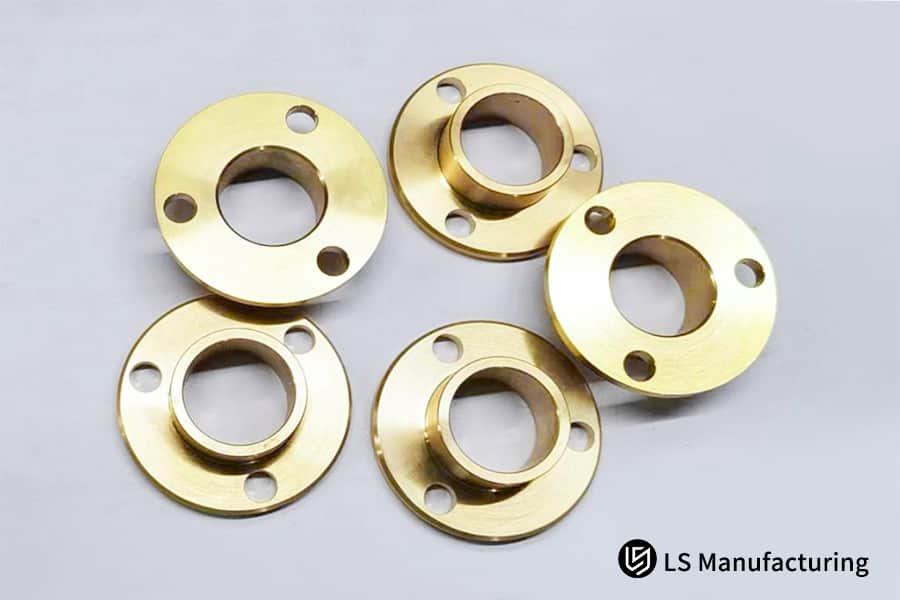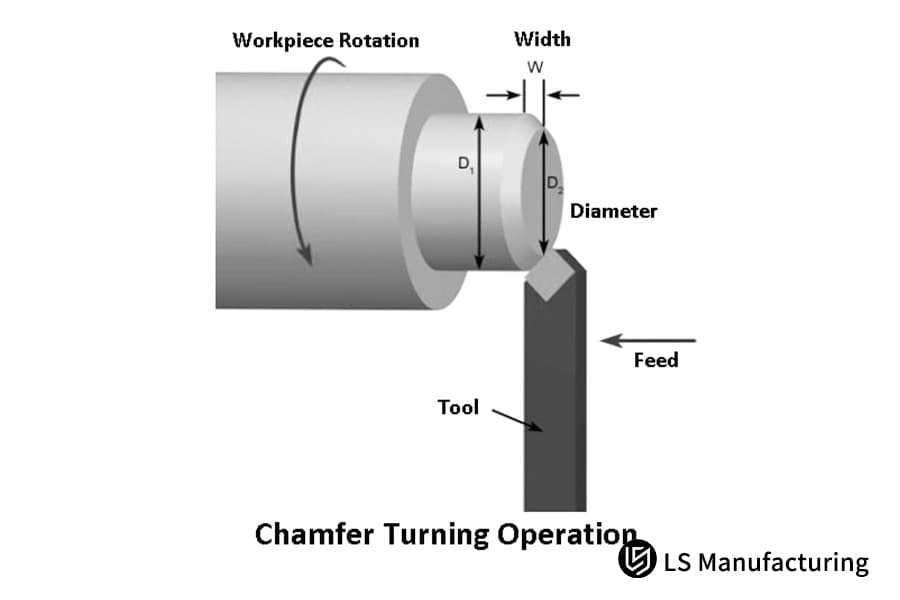LS Manufacturing has established a "zero-defect" engineering system in which highly precise control of the whole process can realize a perfect balance between dimensions and surface finish, making precision manufacturing a key competitive advantage for its customers. In the following analysis, key aspects will be considered to achieve top-level precision and explore how systems engineering methods can turn quality risks into competitive market advantage.

Quick Reference Table For Precision Turning Parts Technology
| Module Classification |
Core Content Summary |
| Precision Grade |
The dimensional tolerance is up to ±0.005mm, and roundness ≤ 0.003mm. |
| Quality | Surface roughness Ra 0.2-0.4μm, up to mirror finish |
| Material Range | It includes stainless steel, titanium alloys, and high-temperature alloys that are difficult to machine. |
| Process Characteristic | Utilizes hard turning technology instead of grinding, which is a turning process. |
| Equipment Configuration | High-precision CNC lathe and mill-turn machining center. |
| Inspection System |
First-piece full inspection + SPC statistical process control is put into practice in the company. |
| Typical Applications | High-precision turning parts such as shafts for medical devices, and fasteners for aerospace. |
| Certification |
Passes industry-specific certifications like ISO13485 and AS9100. |
CNC precision turning parts manufacturing should be a systematic project, requiring coordinated assurance across machine tool precision, process design, and quality control. Advanced technologies like hard turning, constant temperature control, and online measurement enable micron-level precision stability. When selecting a supplier, it's critical to evaluate not just equipment, but also their process database, quality traceability system, and industry experience. These factors collectively determine part quality reliability and consistency.
Why Trust This Guide? Practical Experience From LS Manufacturing Experts
LS Manufacturing has fifteen years of production experience in high-end precision turning. We turn engine rotor shafts for aerospace customers, with radial runout accuracy controlled within 0.005mm. We perform implant bone screw turning for medical companies with micron-level thread precisions, and manufacture vacuum chamber shafts for semiconductor equipment with Ra0.4μm sealing surface finish. In addition, we acquired core capabilities in high-temperature alloy cutting and deformation prevention of thin-walled parts by accumulating this experience.
Our process system strictly follows the surface integrity standard of American Surface Foundation(NASF) and refers to Aluminium Association(AAC) material specifications. We have established a set of solutions covering materials, tool parameters, and precision control through mill-turn machining and online measurement technology, solving many problems in the industry, such as deep hole turning vibration and deformation of thin-walled parts.
According to the real data of over 50,000 pieces of machined parts, we established a complete process library from raw material to finished product. This manual introduces hard turning technology and mill-turning collaboration solutions that have been mass-produced and verified in the aerospace and medical equipment industry. It helps readers systematically master the key points of precision turning technology, avoid common machining defects, and achieve quality stability in mass production.

Figure 1: Exhibition of Precision-Turned CNC Components by LS Manufacturing
What Is True Precision Turning?
Precision CNC turning is much more than a simple operation of "machining a workpiece to a specified size"; it is an integrated systematic engineering project entailing machine tool precision, process control, and inspection and verification. True CNC precision turning parts must meet four consistency requirements simultaneously: dimensional tolerances, geometric accuracy, surface quality, and material properties. The core of the whole process is the achievement of measurable, repeatable, and traceable manufacturing output. The following are the core dimensions constituting precision turning:
Microscopic control of dimensional tolerances
Comprehensive Geometric Accuracy Guarantee
Multi-dimensional evaluation of surface integrity
Besides, superior surface quality characterized by a roughness average (Ra) of ≤0.4μm and a mean peak-to-valley height (Wt) of ≤0.1μm should be pursued simultaneously. With the help of advanced CBN tools and constant surface speed cutting technology, it is possible to achieve an exceptional mirror finish of Ra 0.2μm even on difficult-to-machine materials like titanium alloy. This level of surface integrity is critical for reducing friction and enhancing the fatigue life of dynamic components.
Hidden Requirements for Material Consistency
What is CNC precision turning? Fundamentally, it realizes "zero-defect" manufacturing through a systemic process chain. The ceramic bushings we supply to lithography machines not only have a diameter tolerance of ±0.003mm but also a roundness deviation of ≤0.001mm across all batches and a surface roughness Ra of 0.1μm. This comprehensive quality control capability makes the CNC precision-machined parts the cornerstone of high-reliability products.
How Does The Quality Control System For Precision Turning Work?
With CNC turning quality control applies data-driven thinking to ensure consistency is achieved for small batches up into tens of thousands of precision-machined parts. This comprehensive quality assurance system follows through the entire manufacturing chain, from raw material certification to final product inspection, ensuring all processes are standardized and verified with advanced statistical methods and non-contact testing. This end-to-end traceability is fundamental for guaranteeing part quality and lot-to-lot uniformity.
| Control Link | Key Control Points |
| Material inspection | Tests of raw material chemical composition; mechanical properties according to standards are required. |
| Process control | SPC (Statistical Process Control) is used to monitor the stability of critical dimensions in real time. |
| Tool management | Development of a tool-life prediction model to enable proactive tool changes. |
| On-machine inspection | In-process measurement using a machine tool probe to achieve real-time compensation. |
| Final Inspection | All dimensions to be checked by the coordinate measuring machine to ensure conformance to drawing requirements. |
| Surface inspection | Surface quality is assessed using a roughness tester, and parameters such as Ra and Rz are controlled. |
| Document Traceability | Full quality records will be established to provide for accurate traceability of defective parts. |
The dimensional stability of these high-precision machined parts is consistently maintained through our advanced manufacturing processes. This reliability is further enhanced by continuous analysis of production data and ongoing optimization of process parameters. Such high precision turned components benefit tremendously from this systematic approach, which provides complete accountability and validates the integrity of every manufactured component throughout the entire production lifecycle.
Which Are The Key Processes That Make High Precision Turning Possible?
The essence of true precision CNC turning is dynamically matching the best combination in the CNC turning process according to material properties, structure complexity, and precision. Scientific process optimization can promote machining efficiency and quality stability effectively in conditions involving difficult-to-machine materials and complex geometries. Key process steps that determine machining quality include the following.
- Mill-Turning Composite Technology Expands Machining Dimensions: Complex features such as axial holes and radial grooves can be machined in one setup by coordinated control of spindle indexing and milling power head. Examples of such machining are medical bone plates where optimization of processes like threaded holes and locating grooves is carried out together. This reduces positional accuracy errors from ±0.1 to ±0.02mm by avoiding cumulative errors resulting from multiple setups.
- Customized Material Cutting Parameter Library: A cutting speed-feed rate-depth-of-cut relation model has been established for those hard-to-cut materials like titanium alloy and Incon 718. In the precision CNC turning of TC4 titanium alloy, the use of low-temperature oil mist cooling and microamplitude vibration control enhanced the tool life 3 times and reduced the surface residual stress by 40%, hence ensuring stability in the precision CNC turning.
- High-speed hard turning technology replaces grinding: The hardened steel, HRC55-65, may undergo direct finish turning with CBN/PCBN tools and can realize a mirror finish up to Ra0.2μm with high-speed cutting at 800m/min and negative chamfering edge design. This advanced CNC turning process provides a 50% efficiency improvement in the process compared with traditional grinding without the hazard of grinding burns.
- Thermal deformation compensation strategy: The AI algorithm predicts the trend in spindle thermal elongation upon infrared thermal image monitoring of machine tool heat sources. During the continuous machining of long shaft parts, real-time compensation in the Z-axis displacement is conducted to control the fluctuation of the diameter within 0.008mm for precision CNC turning, ensuring long-term stability.
Precision turning is actually a very important and highly concentrated expression of process optimization capability. Based on its profound process database, this precision CNC turning capability makes up the core technological barrier by systematically integrating and innovating the CNC turning processes to provide customers with solutions beyond the conventional machining level.

Figure 2: Gold-plated precision turned flange assembly by LS Manufacturing
How To choose A Reliable Precision Turning Supplier?
Metrological testing capabilities are a basic requirement
Quality certification system assurance process specifications
The engineering team experience defines the upper boundary:
Assess the ability of the supplier in solving special cases, such as anti-deformation solutions for thin-walled parts and tool life optimization for tough-to-machine materials. Excellent engineers are able to take the initiative in avoiding machining chatter by simulating the cutting process and controlling scrap rate at less than 0.1%.
The core of supplier evaluation should, therefore, be in finding those partners that exhibit superior technical capabilities, combined with a strong quality culture. LS Manufacturing precision turning displays CPK values in real time on a digital quality dashboard so that customers can monitor production quality remotely. This evidence-based evaluation method works very effectively in mitigating procurement risks and ensuring that precision turning services are always under control.
How To Optimize The Cost Of Precision Turning?
- Manufacturability Analysis during the Design Phase: By offering free DFM analysis, our engineering team will provide a comprehensive review for the manufacturability of part designs and recommend reasonable tolerance zones for non-critical features to avoid excessive precision requirements. The reasonable loosening of mating dimension tolerances from IT6 to IT7 reduces machining difficulty and tool wear by 20%, with a 15% shortening of single-piece machining time while functionality is ensured.
- Intelligent optimization and innovation of process routes: Advanced composite turning-milling technology has been introduced in which many clamping operations were integrated into one, greatly reducing the positioning error and auxiliary time. In a certain complex valve body project, process optimization shortened the machining cycle from 12 to 7 hours, while increasing the product qualification rate from 97% to 99.5%, and greatly reduced the rework and quality costs.
- Material Selection: Scientific Evaluation and Alternative Solutions: Based on the real operating condition, we provide more economical material solution suggestions. For instance, in the project for medical device housing, through determining the requirement for corrosion resistance, using 304 stainless steel with surface treatment instead of 316L reduced the material cost by 25% while improving the machinability.
- Production Planning Optimization and Resource Integration: Make small batch orders centrally by grouping similar parts to reduce the frequency of equipment setups and tool changes. In this model, small- and medium-batch orders will be processed with a gain in efficiency of more than 20%, equipment utilization will be increased by 15%, and it will lower the fixed cost per unit effectively.
The essence of precision turning cost optimization is to minimize the total cost through technological innovation. In this respect, LS Manufacturing offers a free DFM analysis service that has enabled customers on average to reduce their overall costs by 20%-30%. This is value co-creation through cost optimization driven by technology and represents the best way for sustainable development in the field of precision machining.
 Figure 3: Brass turned component with internal and external threads by LS Manufacturing
Figure 3: Brass turned component with internal and external threads by LS Manufacturing
How Does LS Manufacturing Address The Challenge Of Precision Turning Hydraulic Valve Cores?
The core valve core products had insufficient machining precision, leading to internal leakage, excessively high rework costs, and jeopardizing this well-known hydraulic equipment manufacturer's market reputation. This case fully demonstrates LS Manufacturing's skill in resolving extreme technical problems.
Detailed Analysis of the Customer's Dilemma
The hydraulic valve core of the company should be ≤1.5 micrometers in roundness error and Ra ≤0.2 micrometers in surface roughness. In the actual production process, the roundness deviation was up to 3-4 micrometers, and obvious vibration marks appeared on the surface, which made the internal leakage rate over three times higher than the standard value. The monthly rework rate reached as high as 15%, and continuous customer complaints severely damaged the brand image.
LS Manufacturing Solutions
Problem solving by our technical team is done through multi-dimensional innovation: first, redesigning the toolpath and adopting the strategy of circular infeed/outfeed to eliminate tool marks; second, using ultra-precision CNC lathes with a constant temperature cooling system in order to control machining temperature fluctuations within ±0.5℃; more importantly, an online roundness measurement system capable of real-time data feedback and automatic compensation for toolpath errors forms a closed-loop control.
Results and Value Creation
With this new process, the valve core's roundness error was controlled within 0.8 micrometers, the surface roughness reached Ra0.1 micrometers, and the leakage rate dropped to one-tenth of the customer's standard. The rework rate of the products fell to zero. The customer completely avoided the quality crisis and even enjoyed a competitive advantage in the market, as the component lifespan increased by 30%, hence over 2 million RMB yearly in terms of quality cost was saved accordingly.
By undertaking systematic process innovation and precise process control, we place emphasis on bringing about not only solutions to the urgent problems of customers but also creating a sustainable competitive advantage. It is this capability to solve the root cause of the problems and achieve quality breakthroughs through technological means that constitutes the value of LS Manufacturing as the preferred partner in the industry.
Any problems with CNC precision turning? Click for professional solutions!
What Are Some Of The Differences In The Turning Requirements Between The Aerospace And Medical Industries?
While medical devices precision turning focus on biocompatibility and sterile surface quality, the main focus of aerospace turned parts is material stability and structural strength in extreme environmental conditions. These differences thus require customized industry solutions if their needs are to be met.
| Comparison Dimensions | Medical Industry Requirements | Aerospace Requirements |
| Material Properties | Biocompatible material, like Ti-6Al-4V ELI, non-cytotoxic | High strength and high-temperature-resistant alloys like Inconel 718 are usable under extreme environments. |
| Quality of the surface | Aseptic finish, Ra≤0.2μm to prevent bacterial growth |
High fatigue strength surface which meets the requirement for long-time high speed running. |
| Tolerances and Accuracy | Emphasize dimensional stability to ensure the precision of implant matching | Accentuate contour accuracy, dynamic balance precision ≤0.01mm. |
| Quality System | Compliant with FDA and ISO 13485, fully traceable | Follows the AS9100 standard, emphasizing process repeatability. |
| Test Specification | Cleanliness test and verification of surface integrity 100% | NDT: penetrant testing, X-ray flaw detection. |
Fundamentally, the difference in application scenarios is what causes differences in precision-machined parts for medical devices and aerospace-machined parts. Our solutions for medical clients highlight surface sterilization and making sure biocompatibility is ensured, while our industry solutions for the aerospace segment focus on performance stability of the materials in extreme conditions.
What Is The Collaboration Process With LS Manufacturing?
The collaboration in LS Manufacturing precision turning is systematic and transparent in order for clients to enjoy seamless service from start to finish. Professional project management and a clear communication mechanism are the core guarantees of our precision turning services. Below is the detailed breakdown of specific steps in this collaboration.
- Requirements Communication and Free DFM Analysis: Our engineering team will provide a free DFM analysis within 24 hours after the client provides product drawings or samples. We suggest optimization in material selection, tolerance design, and process feasibility to help clients avoid potential problems at the very beginning.
- Process Design and Solution Confirmation: A detailed process plan, including planning toolpath and cutting parameters, deploying quality control points will be developed based on the results of DFM analysis by the technical team. The development progress can be reviewed by clients in real-time online, while video conferencing can be used to conduct technical briefings.
- First Article Production and Full-Dimensional Inspection: Before mass production, we produce a first article sample and provide a complete inspection report. Using such equipment as a coordinate measuring machine and a surface roughness tester, we perform 100% inspection of key dimensions to ensure that the product fully meets design requirements.
- Mass Production and SPC Monitoring: In the mass production stage, SPC technology is introduced, which provides real-time monitoring for the key process. Every 50 products will be inspected by sampling, and the process parameters will be dynamically adjusted to ensure batch consistency.
- Final Inspection, Packaging, and On-Time Delivery: All finished products are inspected one last time in their entirety, packaged using rust-proof and impact-resistant materials, and their logistics status is tracked through an information system to ensure delivery on time to the customer's location of choice.
The precision turning collaboration process in LS Manufacturing reflects our high regards for quality and service. Standardized project management methods and transparent communication mechanisms ensure effective progress in every given project. Such a professional model of precision turning service not only assures quality products but also saves customers much time and communication cost, which truly realizes the value concept of win-win cooperation.

Figure 4: Creating a chamfer on a precision CNC machined part by LS Manufacturing
FAQs
1. What is the closest tolerance you can repeatedly maintain?
Under our precision manufacturing system, we can consistently achieve a dimensional tolerance as small as ±0.005mm while the coaxiality and roundness for key geometric features go down to ±0.003mm. Coordinate Measuring Machine inspection reports will be provided with all machined parts.
2. How do you achieve absolute consistency of parts in mass production?
By using an SPC system, we monitor the trend of key dimensions in real time. Automatic compensation for tool wear, with environmental temperature difference control within ±1℃, ensures consistent quality from the first piece to every 10,000 pieces with a CPK value consistently ≥1.67.
3. In your opinion, is my design suitable for precision turning? Optimization suggestions?
We offer free DFM analysis services to optimize the design from the perspective of tolerance rationality and structural manufacturability. An example would be changing chamfer dimensions or wall thickness uniformity to reduce customers' costs by over 20% and to enhance manufacturability.
4. How do you safeguard my product design and intellectual property?
We respect the confidentiality agreement of the NDA and guarantee data security by applying an ISO27001 information security management system. We encrypt and store all design documents, with hierarchical access restriction to production areas to ensure zero risk regarding customers' intellectual property.
5. What are the lead times for small-batch prototypes and mass production?
Precision rapid prototyping products are delivered in 5-7 business days, with expedited 3-day service available. Mass production is precisely scheduled according to the quantity; orders of 1000 pieces generally take about 10-12 days to complete. We synchronize the progress in real time through our ERP system and achieve an on-time delivery rate of over 99%.
6. What if a part fails final inspection?
Non-conforming products are immediately isolated, and an 8D process is started to trace the root cause. Backup production lines are simultaneously activated for rework. We assure 100% delivery of qualified products and take up all additional costs incurred in the process.
7. Is full quality documentation provided including material certifications and test reports?
Every lot is shipped out with an MTC, FAIR, and full-dimensional inspection data. For medical and aerospace parts, heat treatment reports and non-destructive testing records are also provided to meet compliance requirements of those industries.
8. How can I get a detailed quotation and solution for my project?
Please upload your 2D/3D drawings now and specify your requirements. Our experts will provide you with a transparent quotation and solution, including process suggestions, within 2 hours.
Summary
The selection of the CNC precision turning supplier is a strategic decision that affects the core competitiveness of your product. True precision can only be derived from systematic engineering methods, rigorous quality culture, and deep professional experience, not from costly equipment alone. LS Manufacturing has designed a comprehensive system ranging from materials science and process optimization to end-to-end quality monitoring based on years of experience accumulated within the industry, guaranteeing that every single part will meet the most exacting standards.
Don't let minute errors in parts be a bottleneck to your product's success. Upload your drawings now and get a free DFM analysis and an accurate quote from LS Manufacturing experts! Let us provide you with the most reliable quality foundation for your products, leveraging our systematic precision manufacturing capabilities.
📞Tel: +86 185 6675 9667
📧Email: info@longshengmfg.com
🌐Website:https://lsrpf.com/
Disclaimer
The contents of this page are for informational purposes only. LS Manufacturing services There are no representations or warranties, express or implied, as to the accuracy, completeness or validity of the information. It should not be inferred that a third-party supplier or manufacturer will provide performance parameters, geometric tolerances, specific design characteristics, material quality and type or workmanship through the LS Manufacturing network. It's the buyer's responsibility. Require parts quotation Identify specific requirements for these sections.Please contact us for more information.
LS Manufacturing Team
LS Manufacturing is an industry-leading company. Focus on custom manufacturing solutions. We have over 20 years of experience with over 5,000 customers, and we focus on high precision CNC machining, Sheet metal manufacturing, 3D printing, Injection molding. Metal stamping,and other one-stop manufacturing services.
Our factory is equipped with over 100 state-of-the-art 5-axis machining centers, ISO 9001:2015 certified. We provide fast, efficient and high-quality manufacturing solutions to customers in more than 150 countries around the world. Whether it is small volume production or large-scale customization, we can meet your needs with the fastest delivery within 24 hours. choose LS Manufacturing. This means selection efficiency, quality and professionalism.
To learn more, visit our website:www.lsrpf.com.









